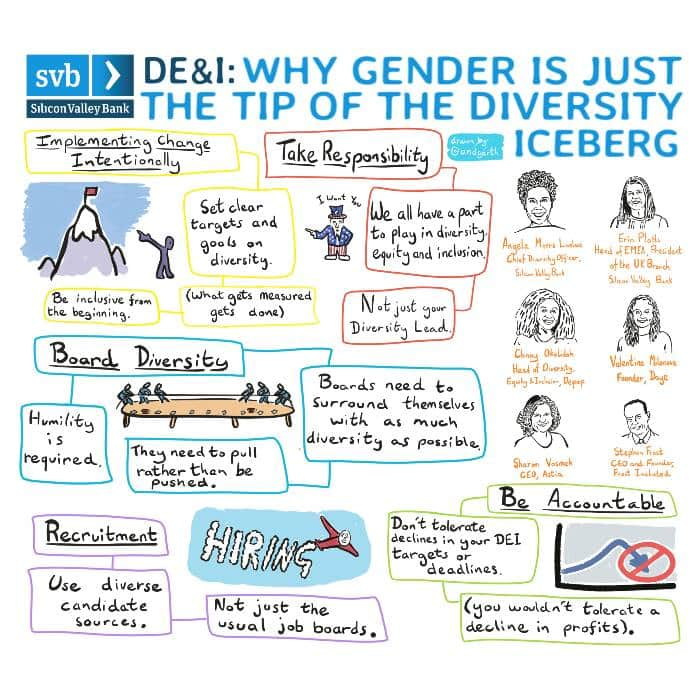Key Takeaways
- Define your mission, know what you want to achieve, and set clear goals and targets so the results can be seen. What gets measured, gets done.
- Gender equity on boards should not be an initiative or a ‘nice to have’, it’s fundamental to good governance and the very purpose of a board.
- Empower people to take responsibility and drive DEI in whatever capacity in their day job.
Our recent Diversity, Equity and Inclusion (DE&I) webinar focusing on gender diversity highlighted how real change requires a clear strategy and continual commitment.
The expert panel members’ lived experience and investor, founder and DE&I-professional perspectives generated valuable insights and best practices for startups and later-stage companies working to create tangible change and maintain diverse teams and inclusive cultures.

Here we share five key tips from the event.
1. Implement change intentionally
Intentionality is crucial. Define your mission, know what you want to achieve, and set clear goals and targets so the results can be seen. What gets measured, gets done.
“Show that you’re working towards something as opposed to coming up with arbitrary things like ‘we want to increase gender diversity’. How? By how much? What are you working towards?”, said Chinny Okolidoh, Head of DE&I at Depop, who discussed the positive impacts Depop has achieved by doing so.
Being inclusive from the outset helps to clarify expectations, embed processes and foster intended outcomes. As CEO of an organisation that invests in and advises high-growth companies led by women leaders, Sharon Vosmek described how they were intentionally diverse from day one and apply an enduring approach: “We’re now more than 5,000-strong, half men, half women, but you don’t become that way accidentally. You do it because all the way along you’re measuring.”
2. Board diversity
No matter how brilliant individual board members are, humility is required with the volume of data, information and thinking now needed to run companies successfully. Boards need to be surrounded with as much diversity as possible. Having robust conversations and examining challenges and issues from multiple angles is an important part of growing a company. Gender equity on boards should not be an initiative or a ‘nice to have’, it’s fundamental to good governance and the very purpose of a board.
DE&I expert Stephen Frost laid out the importance of initiating dialogues with boards so securing gender equity becomes reframed as core work: “That’s when it becomes a data conversation with targets, shortlists. It’s a strategy problem to solve, just as you would with any other business conversation. When a board is pulling, rather than being pushed, things happen and it’s baked into succession planning, the skills audit, into everything you need to tangibly mark the improvement in representation year to year.”
3. Recruitment
Building a diverse team of strong talent requires reaching the widest possible pool of candidates. Valentina Milanova, founder of Daye, described the rule they have whenever they hire in a new market: “We build a diverse hiring job board list so every role we advertise is not just on Hired and Angel.com but also on specific Slack channels and websites that focus on diverse candidates.” Partnering with diversity-focused organisations can also help you reach out to people from diverse backgrounds.
In order to eliminate barriers and bias from the recruiting process and attract premium talent, get your house in order then let people know about it. Look internally to understand fully your company culture and if it supports the diversity you aim to achieve, and communicate that externally. “Let people know they can come and be their best selves and it’s not just lip service – we’ve done the work internally. Expressing the benefits you offer speaks volumes to the people you want to bring in,” said Chinny.
4. Responsibility
Everyone has a part to play in DE&I. It is not solely the remit of diversity teams and leads and should be woven into company culture. Empower people to take responsibility and drive DEI in whatever capacity in their day job. It’s important to keep the conversation going as the problems are stickier than the solutions, so create an ongoing dialogue with the space for two-way conversations that include contemporary, relevant topics.
Take personal responsibility for creating change. As a VC, Sharon described Astia’s attitude to removing bias from every stage of the sourcing and screening process: “That’s the obligation of my industry. It’s our job to remove that bias from our investment screening process and from our networks, processes, teams, and ourselves.”
5. Accountability
Creating accountability is critical to achieving success. With clear targets and the data produced by constantly measuring, results and shortfalls will be visible. Ensure there is individual accountability for teams and team members assigned responsibility for outcomes, as there would be normally – apply the same standards to gender diversity as the rest of a business.
As Stephen explained, “We would not tolerate a decline in P&L or other areas of business much longer than a quarter, so if we have the data and track it we can have transparency, accountability, responsibility, assigned roles and so forth.”
You can watch the full replay of the DE&I webinar here.